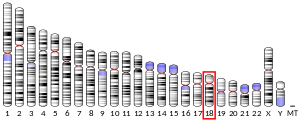Glycosylphosphatidylinositol, or glycophosphatidylinositol, or GPI in short, is a phosphoglyceride that can be attached to the C-terminus of a protein during posttranslational modification. The resulting GPI-anchored proteins play key roles in a wide variety of biological processes. GPI is composed of a phosphatidylinositol group linked through a carbohydrate-containing linker and via an ethanolamine phosphate (EtNP) bridge to the C-terminal amino acid of a mature protein. The two fatty acids within the hydrophobic phosphatidyl-inositol group anchor the protein to the cell membrane.

In enzymology, a dolichol kinase is an enzyme that catalyzes the chemical reaction

Phosphatidylinositol N-acetylglucosaminyltransferase subunit A is the catalytic subunit of the phosphatidylinositol N-acetylglucosaminyltransferase enzyme, which in humans is encoded by the PIGA gene.

GPI transamidase component PIG-T is an enzyme that in humans is encoded by the PIGT gene.

GPI-anchor transamidase is an enzyme that in humans is encoded by the PIGK gene.

Glycosylphosphatidylinositol anchor attachment 1 protein is a protein that in humans is encoded by the GPAA1 gene.

Phosphatidylinositol N-acetylglucosaminyltransferase subunit Q is an enzyme that in humans is encoded by the PIGQ gene.

Dolichol-phosphate mannosyltransferase is an enzyme that in humans is encoded by the DPM1 gene.

Phosphatidylinositol N-acetylglucosaminyltransferase subunit C is an enzyme that in humans is encoded by the PIGC gene.

Phosphatidylinositol-glycan biosynthesis class F protein is a protein that in humans is encoded by the PIGF gene.

GPI transamidase component PIG-S is an enzyme that in humans is encoded by the PIGS gene. This gene encodes a protein that is involved in GPI-anchor biosynthesis.

Phosphatidylinositol glycan anchor biosynthesis class U protein is a protein that in humans is encoded by the PIGU gene.

GPI mannosyltransferase 3 is an enzyme that in humans is encoded by the PIGB gene.

Phosphatidylinositol N-acetylglucosaminyltransferase subunit H is an enzyme that in humans is encoded by the PIGH gene. The PIGH gene is located on the reverse strand of chromosome 14 in humans, and is neighbored by TMEM229B.

GPI mannosyltransferase 2 is an enzyme that in humans is encoded by the PIGV gene.

dolichyl-phosphate mannosyltransferase polypeptide 3, also known as DPM3, is a human gene.

Dolichol phosphate-mannose biosynthesis regulatory protein is a protein that in humans is encoded by the DPM2 gene.
Glypiation is the addition by covalent bonding of a glycosylphosphatidylinositol (GPI) anchor and is a common post-translational modification that localizes proteins to cell membranes. This special kind of glycosylation is widely detected on surface glycoproteins in eukaryotes and some Archaea.

Post-GPI attachment to proteins 1 is a protein that in humans is encoded by the PGAP1 gene.

Phosphatidylinositol glycan anchor biosynthesis class W is a protein that in humans is encoded by the PIGW gene.













